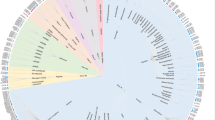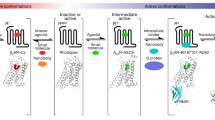Abstract
The recent resolution of G-protein-coupled receptor (GPCR) structures in complex with Na+ bound to an allosteric modulatory site has renewed interest of the regulation of GPCRs by ions. Here, we summarise key data on ion modulation of GPCRs, obtained in pharmacological, crystallographic, mutagenesis and molecular modelling studies. We show that ion modulation is a highly complex process, involving not only cations but also, rather neglected until now, anions. Pharmacotherapeutic and toxicological aspects are discussed. We provide a mathematical framework for the analysis of ion effects. Finally, we discuss open questions in the field and future research directions. Most importantly, the in vivo relevance of the modulation of GPCR function by monovalent ions must be clarified.





Similar content being viewed by others
References
Baird-Heinz HE, Van Schoick AL, Pelsor FR, Ranivand L, Hungerford LL (2012) A systematic review of the safety of potassium bromide in dogs. J Am Vet Med Assoc 240:705–715
Beaulieu J-M, Gainetdinov RR, Caron MG (2009) Akt/GSK3 signaling in the action of psychotropic drugs. Annu Rev Pharmacol Toxicol 49:327–347
Brunskole I, Strasser A, Seifert R, Buschauer A (2011) Role of the second and third extracellular loops of the histamine H4 receptor in receptor activation. Naunyn Schmiedeberg’s Arch Pharmacol 384:301–317
Ceresa BP, Limbird LE (1994) Mutation of an aspartate residue highly conserved among G-protein-coupled receptors results in nonreciprocal disruption of α2-adrenergic receptor-G-protein interactions. J Biol Chem 269:29557–29564
Cetani F, Tonacchera M, Vassart G (1996) Differential effects on NaCl concentration on the constitutive activity of the thyrotropin and the luteinizing hormone/chorionic gonadotropin receptors. FEBS Lett 378:27–31
Chang RS, Synder SH (1980) Histamine H1-receptor binding sites in guinea pig brain membranes: regulation of agonist interactions by guanine nucleotides and cations. J Neurochem 34:916–922
Chien EY, Liu W, Zhao Q, Katritch V, Han GW, Hanson MA, Shi L, Newman AH, Javitch JA, Cherezov V, Stevens RC (2010) Structure of the human dopamine D3 receptor in complex with D2/D3 selective antagonist. Science 330:1019–1095
Collins KD, Neilson GW, Endergy JE (2007) Ions in water: characterizing the forces that control chemical processes and biological structure. Biophys Chem 128:95–104
Connolly TM, Limbird LE (1983) The influence of Na+ on the alpha 2-adrenergic receptor system of human platelets. A method for removal of extraplatelet Na+. Effect of Na+ removal on aggregation, secretion, and cAMP accumulations. J Biol Chem 258:3907–3912
Coppini R, Ferrantini C, Mazzoni L, Sartiani L, Olivotto I, Poggesi C, Carbai E, Mugelli A (2013) Regulation of intracellular Na+ in health and disease: pathophysiological mechanism and implications for treatment. Glob Cardio / Sci Pract 3:222–242
Costa T, Lang J, Gless C, Herz A (1990) Spontaneous association between opioid receptors and GTP-binding regulatory proteins in native membranes: specific regulation by antagonists and sodium ions. Mol Pharmacol 37:383–394
Ericksen SS, Cummings DF, Weinstein H, Schetz JA (2009) Ligand selectivity of D2 dopamine receptors is modulated by changes in local dynamics produced by sodium binding. J Pharmacol Exp Ther 328:40–54
Fenalti G, Giguere PM, Katritch V, Huang X-P, Thompson AA, Cherezov V, Roth BL, Stevens RC (2014) Molecular control of δ-opioid receptor signaling. Nature 506:191–196
Forlenza OV, De-Paula VJR, Diniz BSO (2014) Neuroprotective effects of lithium: implications for the treatment of Alzheimer’s disease and related neurodegenerative disorders. ACS Chem Neurosci 5:443–450
Friedman R (2011) Ions and the protein surface revisited: extensive molecular dynamic simulations and analysis of protein structures in alkali-chloride solutions. J Phys Chem B 115:921–9223
Gibson WJ, Roques TW, Young JM (1994) Modulation of antagonist binding to histamine H1-receptors by sodium ions and by 2-amino-2-hydroxmethyl-propan-1,3-diol HCl. Br J Pharmacol 111:1262–1268
Gierschik P, Sidiropoulos D, Steisslinger M, Jakobs KH (1989) Na+ regulation of formyl peptide receptor-mediated signal transduction in HL60 cells. Evidence that the cation prevents activation of the G-protein by unoccupied receptors. Eur J Pharmacol (Mol Pharmacol) 172:481–492
Gierschik P, Moghtader R, Straub C, Dieterich K, Jakobs KH (1991) Signal amplification in HL-60 granulocytes: evidence that the chemotactic peptide receptor catalytically activates guanine-nucleotide-binding regulatory proteins in native plasma membranes. Eur J Biochem 197:725–732
Grandjean EM, Aubry JM (2009) Lithium: updated human knowledge using an evidence-based approach. Part II: clinical pharmacology and therapeutic monitoring. CNS Drugs 23:331–349
Higashijima T, Ferguson KM, Sternweis PC (1987) Regulation of hormone-sensitive GTP-dependent regulatory proteins by chloride. J Biol Chem 262:3597–3602
Hofmeister F (1888) Zur Lehre der Wirkung der Salze. Arch Exp Pathol Pharmakol (Leipzig) 24:247–260
James LP, Farrar HC, Griebel ML, Bates SR (1997) Bromism: intoxication from a rare anticonvulsant therapy. Pediatr Emerg Care 13:268–270
Joung IS, Cheatham EE (2008) Determination of alkali and halide monovalent ion parameters for use in explicitly solvated biomolecular simulations. J Phys Chem B 112:9020–9041
Katritch V, Fenalti G, Abola EE, Roth BL, Cherezov V, Stevens RC (2014) Allosteric sodium in class A GPCR signalling. Trends Biochem Sci 39:233–244
Kleemann P, Papa D, Vigil-Cruzs, Seifert R (2008) Functional reconstitution of the human chemokine receptor CXCR4 with Gi/Go-proteins in Sf9 insect cells. Naunyn Schmiedebergs Arch Pharmacol 378:261–274
Krautwurst D, Seifert R, Hescheler J, Schultz G (1992) Formyl peptides and ATP stimulate Ca2+ and Na+ inward currents through non-selective cation channels via G-proteins in dibutyryl cyclic AMP-differentiated HL-60 cells. Involvement of Ca2+ and Na+ in the activation of beta-glucuronidase release and superoxide production. Biochem J 288(Pt 3):1025–1035
Lefkowitz RJ, Cotecchia S, Samama P, Costa T (1993) Constitutive activity of receptors coupled to guanine nucleotide regulatory proteins. Trends Pharmacol Sci 14:303–307
Limbird LE, Speck JL, Smith SK (1982) Sodium ion modulates agonist and antagonist interaction with the human platelet alpha 2-adrenergic receptor in membrane and solubilized preparations. Mol Pharmacol 21:609–617
Liu W, Chun E, Thompson AA, Chubukov P, Xu F, Katritch V, Han GW, Roth CB, Heitman LH, Ijzerman AP, Cherezov V, Stevens RC (2012) Structural basis for allosteric regulation of GPCRs by sodium ions. Science 337:232–235
Lo Nostro P, Ninham BW (2012) Hofmeister phenomena: an update on ion specificity in biology. Chem Rev 112:2286–2322
Lombardo F, Maggini M, Gruden G, Bruno G (2013) Temporal trend in hospitalizations for acute diabetic complications: a nationwide study, Italy 2001–2010. PLoS One 8:e63675
Mähler J, Persson I (2012) A study of the hydration of the alkali metal ions in aqueous solution. Inorg Chem 51:425–438
Marlinge E, Bellivier F, Houenou J (2014) White matter alterations in bipolar disorder: potential for drug discovery and development. Bipolar Disord 16:97–112
Martin S, Botto JM, Vincent JP, Mazella J (1999) Pivotal role of an aspartate residue in sodium sensitivity and coupling to G proteins of neurotensin receptor. Mol Pharmacol 55:210–215
May M, Jordan J (2011) The osmopressor response to water drinking. Am J Physiol Regul Integr Comp Physiol 300:R40–R46
Miller-Gallacher JL, Nehme R, Warne T, Edwards PC, Schertler GFX, Leslie AGW, Tate CG (2014) The 2.1 Å resolution structure of cyanopindolol-bound β1-adrenoceptor identifies an intramembrane Na+ ion that stabilises the ligand-free receptor. PLoS ONE 9:e92727
Motulsky HJ, Insel PA (1983) Influence of sodium on the alpha 2-adrenergic receptor system of human platelets. Role for intraplatelet sodium in receptor binding. J Biol Chem 258:3913–3919
Neve K (1991) Regulation of dopamine D2 receptors by sodium and pH. Mol Pharmacol 39:570–578
Neve KA, Cox BA, Henningsen RA, Spanoyannis A, Neve RL (1991) Pivotial role for aspartate-80 in the regulation of dopamine D2 receptor affinity for drugs and inhibition of adenylyl cyclase. Mol Pharmacol 39:733–739
Nickl K, Gardner EE, Geiger S, Heilmann J, Seifert R (2008) Differential coupling of the human cannabinoid receptors hCB1R and hCB2R to the G protein Gαi2Gβ1γ2. Neurosci Lett 447:68–72
Pacheco MA, Ward SJ, Childers SR (1994) Differential requirements of sodium for coupling of cannabinoid receptors to adenylyl cyclase in rat brain membranes. J Neurochem 62:1773–1782
Pop N, Igel P, Brennauer A, Cabrele C, Bernhardt GN, Seifert R, Buschauer A (2011) Functional reconstitution of human neuropeptide Y (NPY) Y2 and Y4 receptors in Sf9 insect cells. J Recept Signal Transduct Res 31:271–285
Rembert KB, Paterova J, Heyda J, Hilty C, Jungwirth P, Cremer PS (2012) Molecular mechanism of ion-specific effects on proteins. J Am Chem Soc 134:10039–10046
Schetz JA (2005) Allosteric modulation of dopamine receptor. Mini Rev Med Chem 5:555–561
Schetz JA, Sibley DR (2001) The binding-site crevice of the D4 dopamine receptor is coupled to three distinct sites of allosteric modulation. J Pharmacol Exp Ther 296:359–363
Schneider EH, Schnell D, Papa D, Seifert R (2009) High constitutive activity and a G-protein-independent high-affinity state of the human histamine H4-receptor. Biochemistry 48:1424–1438
Schnell D, Seifert R (2010) Modulation of histamine H3 receptor function by monovalent ions. Neurosci Lett 472:114–118
Seifert R (2001) Monovalent anions differentially modulate coupling of the β2-adrenoceptor to Gsα splice variants. J Pharmacol Exp Ther 298:840–847
Seifert R, Wenzel-Seifert K (2001) Unmasking different constitutive activity of four chemoattractant receptors using Na+ as universal stabilizer of the inactive (R) state. Receptors Channels 7:357–369
Seifert R, Wenzel-Seifert K (2002) Constitutive activity of G-protein-coupled receptors: cause of disease and common property of wild type receptors. Naunyn Schmiedeberg’s Arch Pharmacol 366:381–416
Selent J, Sanz F, Pastor M, De Fabritiis G (2010) Induced effects of sodium ions on dopaminergic G-protein coupled receptors. PLOS Comput Chem 6:e10000884
Selley DE, Cao C-C, Liu Q, Childers SR (2000) Effects of sodium on agonist efficacy for G-protein activation in μ-opioid receptor-transfected CHO cells and rat thalamus. Br J Pharmacol 130:987–996
Shang Y, LeRouzic V, Schneider S, Bisignano P, Pasternak GW, Filizola M (2014) Mechanistic insight into the allosteric modulation of opioid receptors by sodium ions. Biochemistry 53:5140–5149
Shimamura T, Shiroishi M, Weyand S, Tsujimoto H, Graeme W, Katritch V, Abagyan R, Cherezov V, Liu W, Han GW, Kobayahi T, Stevens RS, Iwata S (2011) Structure of the human histamine H1 receptor complex with doxepin. Nature 475:65–70
Simon Bulley SB, Jaggar JH (2014) Cl channels in smooth muscle cells. Pflugers Arch 466:861–872
Soper AK, Weckström K (2006) Ion solvation and water structure in potassium halide aqueous solutions. Biophys Chem 124:180–191
Stepankova V, Paterova J, Damborsky J, Jungwirth P, Chaloupkova R, Heyda J (2013) Cation-specific effects on enzymatic catalysis driven by interactions at the tunnel mouth. J Phys Chem B 117:6394–6402
Treherne JM, Stern JS, Flack WJ, Young JM (1991) Inhibition by cations of antagonist binding to histamine H1-receptors: differential effect of sodium ions on the binding of two radioligands. Br J Pharmacol 103:1745–1751
Tselnicker JF, Tsemakhovich V, Rishal I, Kahanovitch U, Dessauer CW, Dascal N (2014) Dual regulation of G proteins and the G-protein-activated K+ channels by lithium. PNAS 111:5018–5023
Varma S, Rempe SB (2006) Coordination numbers of alkali metal ions in aqueous solutions. Biophys Chem 124:192–199
Vosahlikova M, Jurkiewicz P, Roubalova L, Hof M, Svoboda P (2014) High- and low-affinity sites for sodium in δ-OR-Gi1α (Cys351-Ile351) fusion protein stably expressed in HEK293 cells; functional significance and correlation with biophysica state of the plasma membrane. Naunyn Schmiedebergs Arch Pharmacol 387:487–502
Watanabe M, George SR, Seeman P (1985) Regulation of anterior pituitary D2 dopamine receptors by magnesium and sodium ions. J Neurochem 45:1842–1849
Wenzel-Seifert K, Hurt CM, Seifert R (1998) High constitutive activity of the human formyl peptide receptor. J Biol Chem 273:24181–24189
Wittmann H-J, Seifert R, Strasser A (2014a) Mathematical analysis of the sodium sensitivity of the human histamine H3 receptor. In silico Pharmacol 2:1–14
Wittmann H-J, Seifert R, Strasser A (2014b) Sodium binding to hH3R and hH4R—a molecular modelling study. J Mol Model. doi:10.1007/s00894-014-2394-2
Yang Z, Liu X-J, Chen C, Hallings PJ (2010) Hofmeister effects on activity and stability of alkaline phosphatase. Biochim Biophys Acta, Proteins Proteomics 1804:821–828
Yuan S, Vogel H, Filipek S (2013) The role of water and sodium ions in the activation of the μ-opioid receptor. Angew Chem Int Ed 52:10112–10115
Acknowledgments
We acknowledge the collaboration with Dr. D. Schnell, in the hH3R project. This work was supported by grants of the Deutsche Forschungsgemeinschaft (GRK 1910, GRK 1441, SFB 587) and the European Union (COST programme BM0806 (H4R network)).
Author information
Authors and Affiliations
Corresponding author
Rights and permissions
About this article
Cite this article
Strasser, A., Wittmann, HJ., Schneider, E.H. et al. Modulation of GPCRs by monovalent cations and anions. Naunyn-Schmiedeberg's Arch Pharmacol 388, 363–380 (2015). https://doi.org/10.1007/s00210-014-1073-2
Received:
Accepted:
Published:
Issue Date:
DOI: https://doi.org/10.1007/s00210-014-1073-2




